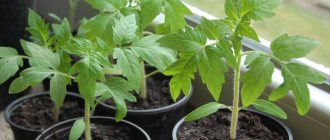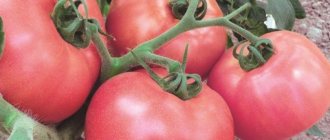What everyone loves is cherry tomatoes. Breeders from Siberia delighted gardeners and introduced a new variety, Sweet Kiss. The tiny fruits are recognized as the most sugary in the world. And they are rightfully considered one of the most beautiful and delicious.
| Height | Landing location | Ripening time | Fruit color | Fruit size | Origin | Fruit shape |
| Medium height | Greenhouse, Open ground | Mid-season | Reds | Small | Variety | Round |
Description and characteristics of the variety
The variety bears fruit throughout the summer-autumn season and has prolonged fruiting.
Cherry tomatoes Sweet Kiss ripen in 106-122 days from germination. They belong to the group of mid-season varieties.
What are the features of tomatoes:
- average weight 20-25 g;
- the skin is strong, glossy;
- the color is bright red, rich;
- the pulp has a dense texture, fleshy, juicy;
- the taste is sweet with a hint of honey;
- sugar level reaches 5-5.5%.
The fruits are intended for cocktails, salads, and decoration of holiday dishes. They are preserved for the winter. Assorted dishes are being prepared. Add to meat and fish dishes.
Characteristics of bushes:
- height within 0.8-1 m;
- fixation and pinning are necessary;
- inflorescences are simple;
- from 15 to 30 fruits are set on the clusters;
- foliage is moderate;
- shoots are semi-spreading.
The variety belongs to medium-sized standard determinate tomatoes.
Features of growing the variety
According to the characteristics and description of the variety, the Sweet Kiss tomato feels great on fertile soils when grown in greenhouses. It is in greenhouses and greenhouses that you can regulate the temperature and humidity, which is necessary for growing this variety. But, growing Siberian cherry in open ground is not excluded.
Recommended regions for cultivation
The variety adapts perfectly to any climatic conditions. But still, when choosing to grow this variety, you should take into account that small sweet varieties feel comfortable in warm conditions. Therefore, it is recommended to grow the variety in a greenhouse, especially in regions with an unstable climate and cold summer nights.
Resistance to diseases and pests
Siberian cherry is highly resistant to various tomato diseases. But it wouldn’t hurt to treat the bushes against pests and diseases with special compounds. The treatment process should be carried out only during the growing period, until the buds of the crop appear.
Growing seedlings
The seeds of the crop are sown 55-60 days before planting the seedlings in open ground. Before sowing, it is necessary to disinfect the planting material from diseases and pests. To do this, you need to place the seeds in a weak solution of potassium permanganate and leave them for several hours.
After which, they must undergo screening. That is, choose good seeds for planting. This is quite easy to do. Those seeds that float to the surface of the water during the disinfection process are not suitable for planting.
Seeds should be sown in containers or boxes at a distance of 2-3 cm and a depth of 2 cm. After which they should be sprayed with a spray bottle and covered with film in order to create a favorable atmosphere for germination. Place containers with seedlings in a bright room with a temperature of no more than +23 degrees.
With the first shoots, seedlings require moderate regular watering, sufficient lighting and fertilization 1-2 times before planting them in the ground.
When 2-3 leaves appear, the seedlings are planted in separate containers. 2 weeks before planting in a permanent place, the seedlings must be taken outside or onto a balcony for hardening and ventilation.
Main characteristics
This tomato is resistant to adverse conditions and can easily tolerate sudden temperature fluctuations. And even in stressful situations it grows well and sets fruit.
Productivity
According to the description, the yield of this variety is high for cherry tomatoes - when growing a Kiss tomato in greenhouse conditions, 20-21 kg of ripe produce can be collected from each m2, and when grown in garden beds - at least 15 kg.
This yield indicator is very high for tomato bushes with small fruits, especially considering that on each square. m of beds, no more than 2 Kiss tomato bushes are planted.
Quality care
The characteristics of a tomato can tell you how to care for it, what conditions to create in order to ensure high-quality growth and abundant fruiting. Caring for small cherry tomatoes is not much different from caring for large varieties, but there are some nuances that must be observed.
- Tall bushes of this variety need staking, otherwise they will fall to the ground under the weight of vegetables.
- Tomatoes need to be provided with high-quality watering, but most importantly, do not overdo it.
- Loosening the soil, hilling, mulching.
- Water with warm water, preferably from a barrel. Water tomatoes into the ground at the root.
- Soak tomato seeds in manganese before planting.
- Spray tomatoes against diseases.
- Do not let the soil turn to stone, loosen it, hill it, mulch it.
- Remove weeds that interfere with the supply of vitamins and nutrition to crops.
- Several times during the summer you need to feed vegetables with mineral and organic fertilizers. Moreover, nitrogen fertilizers can be fed to tomatoes before the ovary forms.
- Spraying with special solutions against insects and diseases.
- Sometimes open the windows and doors of the greenhouse where the tomatoes grow for ventilation.
- If you plant it in open ground, you should always cover it with a film to protect it from dew and cold at night.
A careful attitude will reward you with high-quality fruiting, there will be a lot of fruits, they will be very tasty. If you fulfill all these requirements and take some simple care, then soon these plants will delight your family with delicious little tomatoes.
Diseases and pests
Tomato Kiss is resistant to most diseases characteristic of other tomato varieties.
However, if the rules of agricultural technology (especially the irrigation regime) are not followed, then the bushes of these tomatoes may be subject to fungal diseases or various rots.
EXCELLENT VARIETIES OF TOMATOES!
Tomato Casanova Tomato Summer Resident Description of Bear Paw tomatoes
Therefore, you should monitor the soil moisture, fertilize the tomatoes on time, and also periodically treat the Kiss tomato bushes with Bordeaux mixture or copper sulfate solution.
Among the pests, this variety can be damaged by aphids and the Colorado potato beetle.
Insecticides should be used against them, and many vegetable growers prefer to regularly pick off the Colorado potato beetle by hand.
The last treatment of tomatoes with chemicals should be done no later than a couple of weeks before harvest.
Photo of the Colorado potato beetle on tomatoes
Tomato “Sweet Kiss”: high and high-quality harvest guaranteed
Tomatoes that are small in size are in constant demand, which is why the appearance of the Pleasant Kiss variety was approved by both buyers and entrepreneurs who grow vegetables.
In the breeding work for the development of the variety, Siberian species were used, because Sweet Kiss can also grow well in cold conditions, and in open ground, the hearth adapts to weather changes and is resistant to many diseases inherent in tomatoes.
This variety is classified as small and belongs to mid-season tomatoes. A bush in greenhouse conditions can reach a height of up to 150 cm, unless it is open ground - no higher than 100 cm. The brushes are formed miraculously, so abundantly, and if high-quality care is provided during the ripening period, then the yield will be quite high. On the clusters the fruits are hung in clusters. The inflorescences are simple. The crown is not very thick.
Tomatoes have a rich red color, the vegetable is small in size, the maximum weight of each is 200 grams. Their matrix is round, slightly flattened. The skin is quite dense, has a smooth and shiny edge. The pulp contains a large amount of sugar.
It is thanks to its presence that Molasses Kiss is the leader among tomatoes as the sweetest. Indeed, its taste is unique, as is its rich aroma.
Therefore, this variety is actively used fresh - in various salads and slices, as well as canned and pickled products.
After sowing, approximately three months will pass before the harvest can be harvested. What to tie up the Sweet Kiss bushes, having prepared the support in advance, you will need to form the stems.
Otherwise, either the seedlings are grown independently, or the seeds are sown 50–60 days before the main planting. This procedure takes place in early spring. First, it is advisable to place the superelite in a special solution, which promotes high-quality germination and helps the plant to fight back the fungus in the future.
While the seedlings are rising and gaining strength, it is necessary to create predominantly favorable conditions: ensure a constant temperature of 22 - 23 degrees Celsius and plant them in a place where it is sunny and light. There is no need for artificial light, a backbone so that the plants are on the sunny side during daylight hours.
If the weather settles, you can take the plants outside so that the important benefits of the Sweet Kiss procedure—ventilation and hardening—occur.
The finished seedlings are placed in uncovered prepared soil or in a closed greenhouse. Experts say that these tomatoes grow better in greenhouse conditions, and they all have time to ripen during the season.
If the climate in the region is cold, and there are no internal reserves to have a greenhouse, in the first period after planting it is permissible to cover the plant with film. This variety prefers good soils, since fertile soil provides such a unique taste, giving the owner a divine harvest.
Planting occurs in May - June. The optimal population of sprouts is 3-4 plants per square meter. m. When planting, you need to remember that there should be free access to each bush. The soil must certainly be prepared - that means, loosened and watered, all weeds must be pulled out, otherwise the plants will not receive enough vitamins and nutrients.
For good seedling growth, brown soil is treated with mineral fertilizers, and fertilizing can also be used. Then the plants will begin to rapidly gain strength, become stronger and bear fruit together.
Nitrogen fertilizers can be used until the ovary appears.
Although tomatoes have excellent disease resistance, professionals advise oiling the plants with special products.
These eggs only produce a high yield if you take care of it relentlessly. Sweet Kiss grows quite quickly, and therefore the seedlings should be tied up immediately. Anyone who has already grown this variety advises using ropes and making sure that the bushes do not fall or break under the weight of the fruit.
Watering should be done systematically, but it is important not to overdo it. Water is poured under the root, it is better to use the settled heat, as the water is stored in large containers on the site. Hilling and mulching are required; the soil should not be rocky.
The Grandmother's Kiss tomato has gained great popularity among gardeners; it is grown by thousands of gardeners in different parts of the country. Tomatoes have an excellent sweet taste, are suitable for any purpose, and with proper care the yield is high. Learn how to properly grow tomatoes so that they bear fruit abundantly during the season.
- Description of the variety
- Landing Features
- Further care
- Reviews from gardeners
Description of the variety
The Grandmother's Kiss tomato is recognized as one of the early varieties. From the moment the seeds are planted for seedlings until fruiting, no more than 85-90 days pass. Tomatoes are suitable for greenhouse planting and for cultivation in open ground. The bushes are frost-resistant: they normally tolerate cold snaps at night, and the shoots do not freeze.
The variety is suitable for cultivation in all regions of the country, including the Urals and Siberia. However, in cold climates it is better to plant tomatoes under film. The yield of Grandmother's Kiss in the season is 4-6 kg from each bush.
Plants are of a determinate type; when grown outdoors, the height of the bush reaches no more than one meter, and under the film it can be a little more. The leaves have an interesting potato-type shape. It is recommended to grow the plant in 2-3 stems for better yield. The stems are plump, but a garter is necessary. The ovaries are formed under the seventh leaf, then repeated every 2-3 leaves.
The uses are varied, large fruits are excellent for fresh consumption and salad cutting, and tomatoes collected from the lower shoots are ideal for canning. Keeping quality and transportation are good, which allows you to pick tomatoes half-ripe and ripen them at home.
READ MORE: Tomato Micah characteristics and description of the variety
In terms of resistance to diseases and pests, tomatoes show only their strengths. Plants and fruits are slightly affected by late blight, powdery mildew, and root rot. Prevention is needed to maintain immune qualities at the proper level, so plants are treated 2 times with fungicides against the development of viruses and fungi.
The advantages of Grandma's kiss are:
- excellent taste of fruits;
- attractive appearance;
- universal purpose;
- high productivity;
- possibility of street landing;
- resistance to viruses.
The variety has no obvious shortcomings; on the contrary, gardeners characterize it positively and recommend it for planting.
Landing Features
Agronomists recommend planting Grandma's Kiss seedlings 60-65 days before the expected date of planting in greenhouse soil or outside.
When planting tomatoes at the end of April, you need to sow the grains at the end of February or beginning of March.
Before planting, the seeds are soaked in a weak solution of potassium permanganate for disinfection, and then the grains are dried a little from excess moisture on a paper sheet. In addition to disinfecting the grains, prepare the following before planting:
- select the container of the required volume. It should be shallow, as transparent as possible, so that soil moisture can be controlled. There should be holes in the bottom of the container to drain excess water. For tomato seedlings, plastic containers with lids and wooden boxes are most often used;
- fertile soil is prepared. To grow seedlings well, the soil must include peat and humus. They feed the roots with the necessary substances, so the plants develop quickly. The soil is calcined in the oven or spilled with a solution of copper sulfate to prevent infection.
Before planting, the container is filled with soil and watered. When the water is absorbed, grooves are made in the soil 1-1.5 cm deep. The distance between two adjacent grooves should be at least 2 cm.
The grains are planted in the soil, sprinkled with a little earth and covered with a film or lid on top. The container with future seedlings is left in a bright and warm room.
The first shoots appear 7-10 days after planting.
They dive Grandma's Kiss in the second leaf phase. When replanting, be careful; it is very easy to injure the delicate root system. After replanting, the cups with seedlings are removed away from the sun for a week so that the plants adapt to the new growing conditions. The picking is carried out once, since the bushes do not outgrow the required size.
Advice!
During the dive, part of the soil is left on the roots of the plant.
Further care
Tomato seedlings are planted in the second half of spring, when the threat of frost has passed and the ground has warmed up to more than 10 degrees Celsius. After replanting, the plants are cared for as follows:
- carry out regular watering with warm, settled water at the root. The frequency of watering depends on the porosity of the soil and the weather in the region. Usually 2-3 times a week is enough, but the rate can be increased if there is a drought. Before watering, be sure to check the dryness of the soil. If the soil is dry at a depth of 5-6 cm, then it is watered;
- loosen and weed the soil to remove weeds. When loosening and weeding, the earth is enriched with oxygen, which the roots need for normal development. Weeding helps plants develop faster;
- feed tomatoes with fertilizers. Feeding should be evenly distributed over 3-4 stages. The first stage is carried out during the third week after planting the seedlings; any additive based on nitrogen is used as fertilizer. Then the emphasis is placed on organic or mineral fertilizing with phosphorus, potassium, magnesium, and calcium. The interval between feedings should be at least 2 weeks. Find out how to feed tomato seedlings so that they have thick stems.
- stepsons are grazing the bushes. For greater yield, the stepsons are removed at the initial stage of appearance. The bush bears fruit most strongly when it is grown in 3 stems, all excess shoots are cut off;
- tie the plants to a trellis. The garter helps relieve the load on the bush, and the tomatoes will ripen faster on the branches. You can tie it not only to a trellis, but also to a high wooden support.
How to grow
Tomatoes are planted in a greenhouse or open soil with sprouted seedlings. These varieties of tomatoes are grown in seedlings. They grow best in greenhouses, where all special conditions are created for them. They love good soil, only then they produce a wonderful harvest.
The seeds are soaked in a special solution for quick germination and against fungus. Treat the soil with potassium permanganate or a fungal spore repellent. Then they are seated, keeping a distance. Usually containers with them are placed on the windowsill. Until the sprouts germinate, they are covered with film. Enough light must always be provided. You don’t have to use artificial light, but always keep plants near the window.
At the beginning of spring, you already need to sow the seeds in special containers. Before sowing, they are treated with a fungal solution. Then cover with film. Seeds germinate well at a temperature of 22 degrees. When the first leaves appear, the film is removed and the shoots are planted separately in cups.
This picking is necessary so that they grow and eat better. During growth, plants need to be provided with sufficient light and water. Don't forget to feed with fertilizers. Then the bushes will begin to gain strength and get stronger day by day.
As soon as good spring weather sets in outside, the seedlings must be taken out onto the balcony for ventilation and hardening.
Sweet varieties always love fertile good soil. It is thanks to her that such a rich taste is obtained. It is prepared in advance: sand, peat, organic and mineral fertilizers, and humus are placed there. Before planting, it is necessary to water well and loosen.
They plant Kiss tomato bushes, measuring the distance so that it is convenient to approach them and for feeding them.
You need to tie up the seedlings right away, as they stretch high and quickly. They are usually knitted with ropes. The yield of the variety largely depends on care.
Views of summer residents
Reviews from summer residents who have ever tried this type of tomato always have positive ratings. Of course, because the amazing taste and subtle alluring aroma are very popular with the whole family, even the smallest members. Fans of this variety annually purchase Kiss seeds to always enjoy this wonderful taste.
Lilia, 56 years old: I planted the tomato variety Sweet Kiss to try. It was not possible to understand the true taste, since this year almost the entire harvest was damaged due to dew. These small tomatoes were born with spots and not very sweet. They made juice from them. Apparently the taste has deteriorated due to illness.
Marina, 44 years old: I have been planting this tomato variety for two years in a row. Satisfied with the harvest. Bright, juicy, aromatic tomatoes. The taste is sweetish. The only negative is that you have to tie up bushes that are too tall. But that's probably all.
Victor, 52 years old: Our family loves cherry tomatoes. They have an extraordinary taste. And we decided to plant the Kiss tomato. We read reviews about it, and chose this variety. We have a northern side in the garden, and there are always constant winds, as well as lowland. But, despite this, the fruits ripened on time, there were many of them.
What everyone loves is cherry tomatoes. Breeders from Siberia delighted gardeners and introduced a new variety, Sweet Kiss. The tiny fruits are recognized as the most sugary in the world. And they are rightfully considered one of the most beautiful and delicious.
| Height | Landing location | Ripening time | Fruit color | Fruit size | Origin | Fruit shape |
| Medium height | Greenhouse, Open ground | Mid-season | Reds | Small | Variety | Round |
Further care for Kiss tomatoes
Further care for the Kiss tomato consists of the following procedures:
- compliance with the irrigation regime;
- carrying out loosening and weeding;
- applying fertilizers;
- prevention of diseases and pest attacks.
INTERESTING!
Varieties of black tomatoes
Irrigation regime
This variety of tomato does not like excessive waterlogging of the soil, so when watering, you need to add enough water so that the soil is saturated to a depth of 15 cm, but there is no stagnation of moisture in it.
Photo of watering tomato
Typically, tomatoes are watered once every 6-7 days, as the top layer of soil dries.
During the rainy season, the amount of watering is reduced to a minimum.
During flowering and fruit ripening, tomatoes require more moisture, so during these periods the tomato bushes are watered once every 2-3 days.
GOOD TO KNOW!
Why do the leaves of tomatoes in a greenhouse dry out and turn yellow?
Loosening and weeding
The root zone of tomatoes should be loosened after each watering or rain to remove the crust that forms from the soil surface. At the same time, all grown weeds are removed.
Photo of loosening the root zone of tomatoes
Feeding
Tomatoes of the Kiss variety should be fed regularly at intervals of 2-2.5 weeks. It is usually recommended to alternate the application of organic and mineral fertilizers.
Photo of tomato feeding
Recommended fertilizers for this tomato variety:
- mullein solution diluted with water in a ratio of 1:10;
- greenfinch - herbal infusion;
- superphosphate;
- potassium salt.
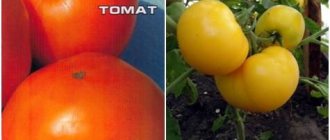
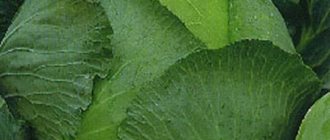
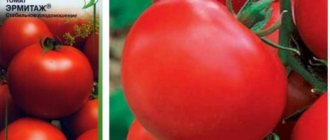


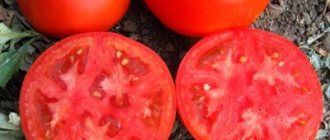
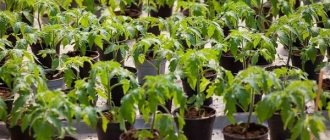
![Tinkoff (Debit card) [CPS] RU](https://adzumi-sushi.ru/wp-content/uploads/tinkoff-debetovaya-karta-cps-ru15-330x140.jpg)

